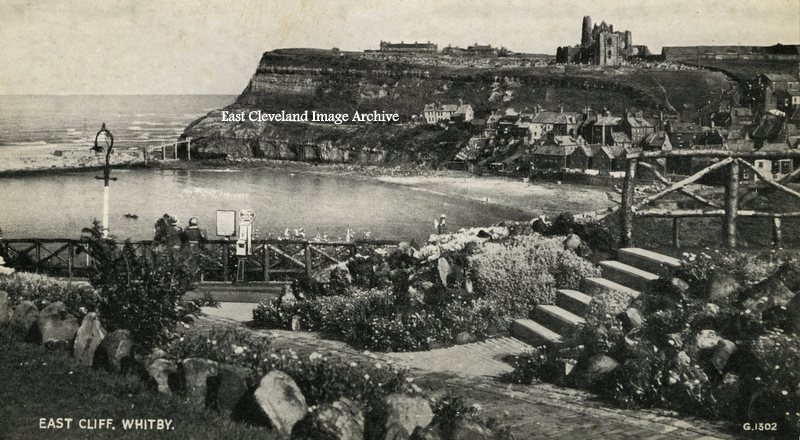
This Valentine’s postcard view taken from above Kyber Pass (just beside the whale bone arch looks towards Whitby Abbey and the east cliff. Dating from the 1950s, the flower beds and hand rails are much changed today.
Image courtesy of Iris Place.
|
|
||
|
This Valentine’s postcard view taken from above Kyber Pass (just beside the whale bone arch looks towards Whitby Abbey and the east cliff. Dating from the 1950s, the flower beds and hand rails are much changed today. Image courtesy of Iris Place.
An un-mailed postcard is from the early 1900s, hand tinted it presents a colourful view of Whitby Abbey and Tate Sands. Image courtesy of Iris Place.
This Photocrom postcard dates from 1909 and is delicately hand tinted. Even in those days the senders were enduring ‘wretched weather’, some things never change. Image courtesy of Iris Place.
This letter card (an envelope with the above image on front) and space on the reverse for stamp and address was believed to date from the 1940s, note the fields where now there are caravans and a chalet park. Also how few vehicles are to be seen, a quieter pace of life. However; we have now been advised by Callum Duff: “Based on the appearance of two buildings, I would date this image between 1925 and 1935. The Pier Theatre was built in 1925 between the two shore end buildings to keep the pier as an attraction after being breached by SS Ovenbeg in 1924. The Assembly Rooms (now The Spa Hotel) was extended with an apron of new windows in 1935 and this work has yet to be started. If somebody knows when Exeter Street and Bristol Avenue were built, the date could be narrowed to something more accurate because it doesn’t look like work has started on this development either.” Image courtesy of Iris Place and many thanks to Callum Duff for assistance in dating the image.
This enchanting postcard view is very aptly entitled, dating from the 1950s; similar views can still be gained and this despite the thronged main and side streets on both sides of the river. Although the younger people are differently dressed today, the older fishermen still bear an uncanny resemblance to those in this view. Image courtesy of Iris Place.
Viewed from the famous 199 steps, this 1960s view of the fish quay and market is still unchanged today, although the numbers of boats regularly using the quay and market is now much reduced. Also the long familiar ice making equip ment is now gone. But the hopeful younger fishermen still throng the harbour sides fishing for crabs and fish. Image courtesy of Irish Place.
Whitby’s Trent Class All-Weather Life Boat ‘George and Mary Webb’ on station at Whitby; the boat arrived in 1994; it has a range of 250 nautical miles and can reach speeds of 25 knots. The boat is designed to lie afloat (it does not have to be launched) as it is ready to go at any time; a useful attribute when considering the history of earlier lifeboats at Whitby and difficult launches. Image courtesy of Iris Place.
A familiar view to all who visit the area is this more modern image of Roseberry Topping; viewed from the lay-by/car parking are as one approaches Newton under Roseberry. At 1,049 feet (320 m), Roseberry Topping was traditionally thought to be the highest hill on the North York Moors however, the nearby Urra Moor is higher, at 1,490 feet (450 m). The top offers views of Captain Cook’s Monument on Easby Moor and the monument on Eston Nab. We are informed: “Until 1912 the summit resembled a sugarloaf, but a geological fault and possibly nearby alum and ironstone mining caused its collapse.” Image courtesy of Iris Place.
This Frith’s postcard view of what is today called The Zetland, is of the former Zetland Hotel; viewed from the entrance to the Valley Gardens on Glenside dates from the 1950s, externally little has changed today. The Hotel is no more and the building is now luxury apartments with stupendous views; although further developments have taken place to the rear of the building. Proposed as a luxury railway hotel by Henry Pease the founder of Saltburn, to promote the resort, it was built 1861 to 1863. Over the years the fortunes of the hotel and the resort declined and by the early 1970s the number of visitors to the town had dropped substantially. Many hotels struggled to survive and had to close. Eventually, the Zetland Hotel also closed in 1983 and was converted into apartments in 1989. Image courtesy of Iris Place.
This Frith’s postcard view will be familiar to many travelling from the south and approaching Saltburn via the infamous Spa Bank! Dating from the 1950s, it is little changed today, the Hotel is no more, but the building is now luxury apartments with stupendous views. Proposed as a luxury railway hotel by Henry Pease the founder of Saltburn, to promote the resort, it was built 1861 to 1863. Over the years the fortunes of the hotel and the resort declined and by the early 1970s the number of visitors to the town had dropped substantially. Many hotels struggled to survive and had to close. Eventually, the Zetland Hotel also closed in 1983 and was converted into apartments in 1989. Today it is simply known as The Zetland. Image courtesy of Iris Place. |
||
Recent Comments